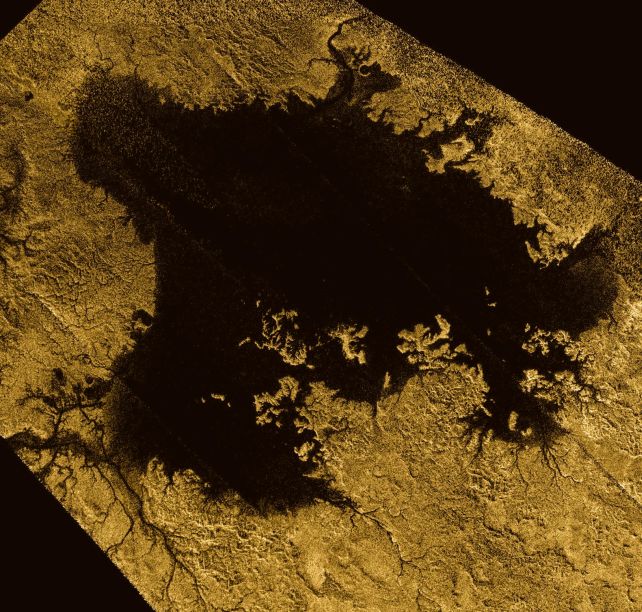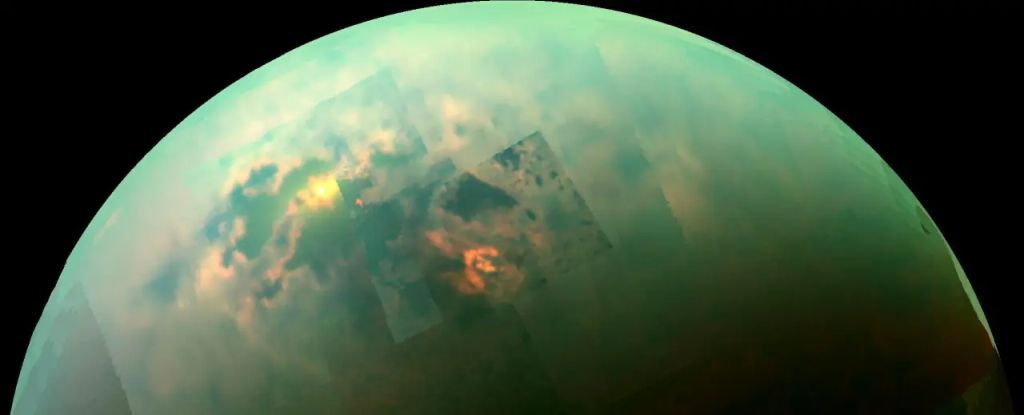The sound of the surf could be the soundtrack to Saturn’s moon Titan.
New analysis shows that the large bodies of liquid methane and ethane that wrap around Titan’s surface are likely populated by waves that erode the shores, carving the shapes of rivers and large lakes unique to the exotic moon and foggy.
This discovery provides fascinating insight into Titan and how liquid bodies can behave on other worlds so different from Earth.
“We can say, based on our results, that if the coastlines of Titan’s seas have eroded, waves are the most likely culprit,” says geologist Taylor Perron of the Massachusetts Institute of Technology (MIT).
“If we could stand at the edge of one of Titan’s seas, we could see waves of liquid methane and ethane crashing ashore and crashing onto the shores during storms. And they would be able to erode the material from which consists of the coast.
Discovered by Christiaan Huygens in 1655, Titan’s surface has been hidden from view by a thick, hazy atmosphere that was formally identified when Gerard Kuiper detected methane in its spectrum in 1944. It was only when the Cassini probe was sent to orbiting Saturn in the early 2000s was the surface of the Kronian Moon described in every detail. Detail that included large, shimmering lakes of liquid hydrocarbons.

Since then, scientists have wondered what these bodies of methane and ethane – some of which rival North America’s Great Lakes in size – are like.
Other than Earth, Titan is the only known Solar System body with giant liquid reservoirs on the surface, and we’re so intrigued. Are its seas stormy and always moving, like Earth’s oceans? Or are they quiet and still, without significant movement?
“Some people who tried to see evidence of waves saw none and said, ‘These seas are as smooth as mirrors,'” says geologist Rose Palermo of the US Geological Survey. “Others said they saw some roughness on the liquid surface, but they weren’t sure if the waves caused it.”
To find out, Perron, Palermo and their colleagues performed detailed modeling, trying to replicate the shapes of waterways and lakes seen in images of Titan.
First, they looked at Earth, performing modeling to understand how different mechanisms of coastal erosion shape the shores of bodies of water such as lakes and oceans. This gave them a basic framework for using shoreline morphology to distinguish the different erosion processes that can occur around a body of liquid.
They then applied this framework to Titan, looking at three specific scenarios: one in which there was no coastal erosion; a second in which erosion was driven by waves; and a third in which erosion was a uniform process, where the coastal material gradually disintegrated, or fell under its own weight.
Of particular importance is a property known as fetch, the distance over which a wind can travel unimpeded over a body of liquid, transferring energy to the liquid surface as it goes. The longer a wind can travel, the more energy is transferred and the wilder the surface grows.
“Wave erosion is driven by wave height and angle,” says Palermo. “We used fetch to approximate wave height because the greater the fetch, the longer the distance the wind can blow and the waves can grow.”

According to their simulations, the three scenarios produced very different coastlines. The ones that most closely resembled the real Titan are the ones in which the waves crashed or crashed into the shores. And those with uniform erosion ended up as lakes on Earth, eroded in the same way as limestone disintegrates.
It’s not concrete proof, of course. We won’t know if there are waves on Titan until we get there and take a closer look. There’s a mission in the works to do just that, called Dragonfly. It’s currently scheduled to arrive on Titan in 2034, so we’ll have to wait until then.
“Titan presents this case of a completely intact system,” says Palermo. “This can help us learn more fundamental things about how coasts erode without human influence, and perhaps it can help us better manage our coastlines on Earth in the future.”
The research was published in Advances in science.
